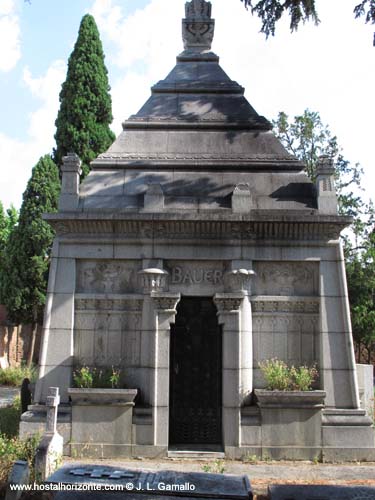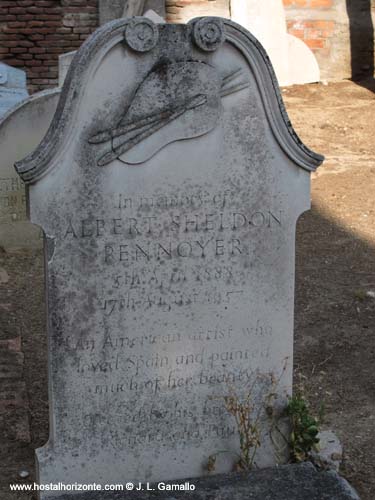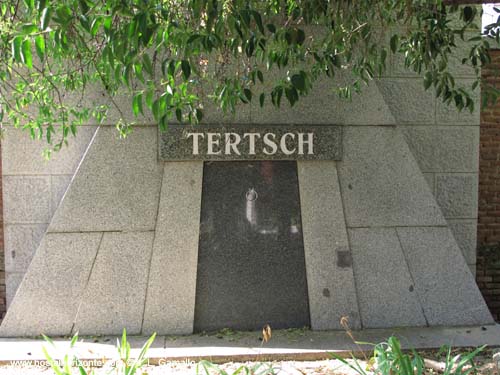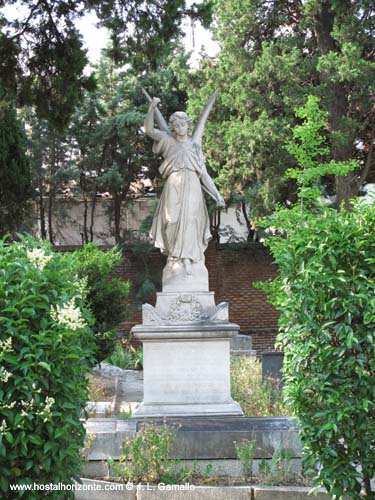Hostal HorizonteBlog / The unknown British cemetery in Madrid (Spain)
The unknown British cemetery in Madrid (Spain)
J. L. Gamallo. The British cemetery dating back to 1854, when the Madrid City Council gave permission for its construction and was intended for Christians (British) non-Catholics. With time not limited only to the British, and allied (Canadians, Australians, Americans) but expanded the list to other religious, such as Lutherans, Orthodox or Jewish. Really worth visiting for an hour or so and enjoy a British cemetery in Madrid, very evocative and pleasant garden. It also has some burials of great artistic and historical interest. There are many tombs of the late nineteenth and early twentieth centuries who lived in Madrid, diplomats, artists, engineers, writers, military, nobles.etc.

This should highlight the great Egyptian style mausoleum of Bauer banking family, related to the Rothschilds, your palace of San Bernardo Street was one of the most brilliant social life of the late nineteenth Madrid.

There are also the tombs of the founder of the famous restaurant Lhardy, the tomb of the founder of the house of Loewe luxury accessories, or industrial Boetticher. The tombs of the Lhardy and Loewe are of great simplicity. There are some curious, as the young Arthur Williams who died at age 19 in 1854, being the oldest grave in the cemetery, as it was called Arthur on his tomb is carved the sword Excalibur, stuck in the rock.It is curious tomb naval engineer John Williams, who died in Madrid after three days of arrival of a congestion of the lungs (congestion of the lungs) at 45 years (1890).

A palette with two paintbrushes shows us the grave of Albert Sheldon Pennoyer American painter, who died in Madrid in a road accident, had come with the intention of painting Spanish castles. The name of the eminent historian Alice Bache Gould resting on a stone open book on the floor. It was a great Spanish scholar who investigated about Christopher Columbus and Isabella I of Castile. Death surprised at Simancas General Archive headquarters.

In 1952 he was awarded with the Order of Isabel the Catholic. There are a few graves of British soldiers dead during World War II, it seems that inspired the novels of Ian Fleming, the creator of 007. Also related to this conflict is a pyramidal tomb in large letters just puts Tertsch. Here is buried the Austrian journalist and diplomat, joined the Nazi party Ekkehard Tertsch, who in 1943 was appointed deputy head of press at the German embassy in Madrid.

He was arrested by the Gestapo on suspicion of having collaborated in the assault on Hitler (20-8-1944), and taken to the concentration camp Sachsenhaussen. At the end of 1945 was released, along with many other prisoners from that field, in Schwerin by the Allies, who reported on the living conditions of the field. However in 1945 he fled to Spain, and here away in 1989.

In the center of the cemetery stands the tomb of Indiana Ierne, Washingon born and died in Madrid in 1876, her husband did a beautiful marble monument surmounted by an angel. The tomb of Arnt and Tatiana (born in St. Petersburg), Korff barons also reminds us of the dramatic twentieth-century European history during the Russian Revolution and World War II.

Interestingly Tatiana was Orthodox, and Arnt, perhaps his son, was a Catholic. They died in 1961 and 1980, respectively, like that of Polish aristocrat Nicholas Witold, Count (last in line) Zawadowski Miklaszewski (1903-1971). It's best to approach this oasis of tranquility and beauty, and meditate on these bits of history.
- blog de Kamalus
- Inicie sesión para enviar comentarios

